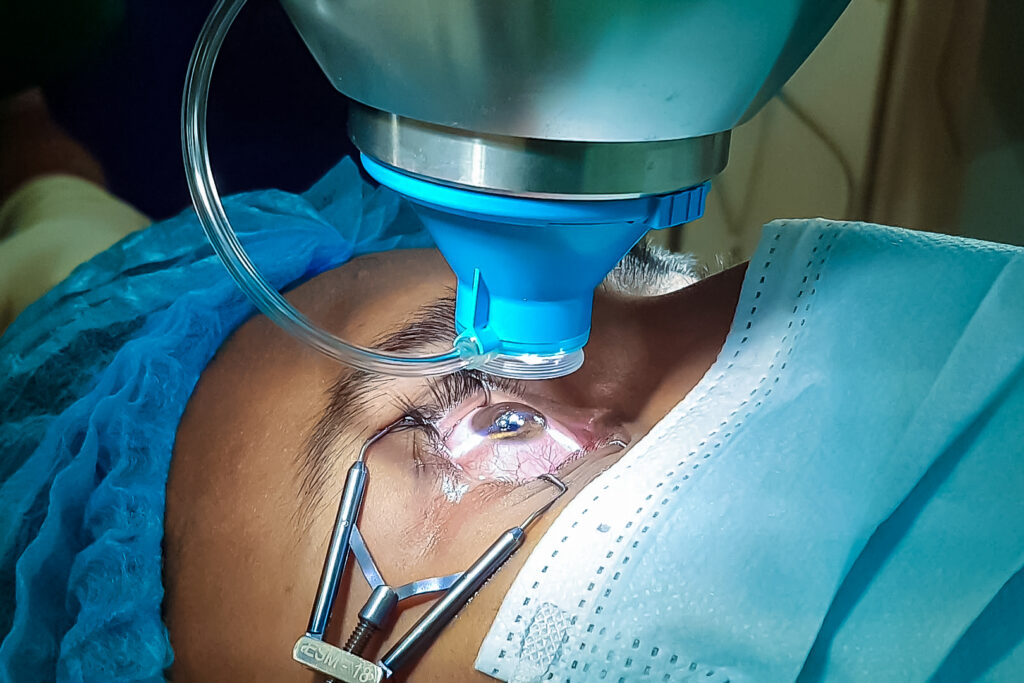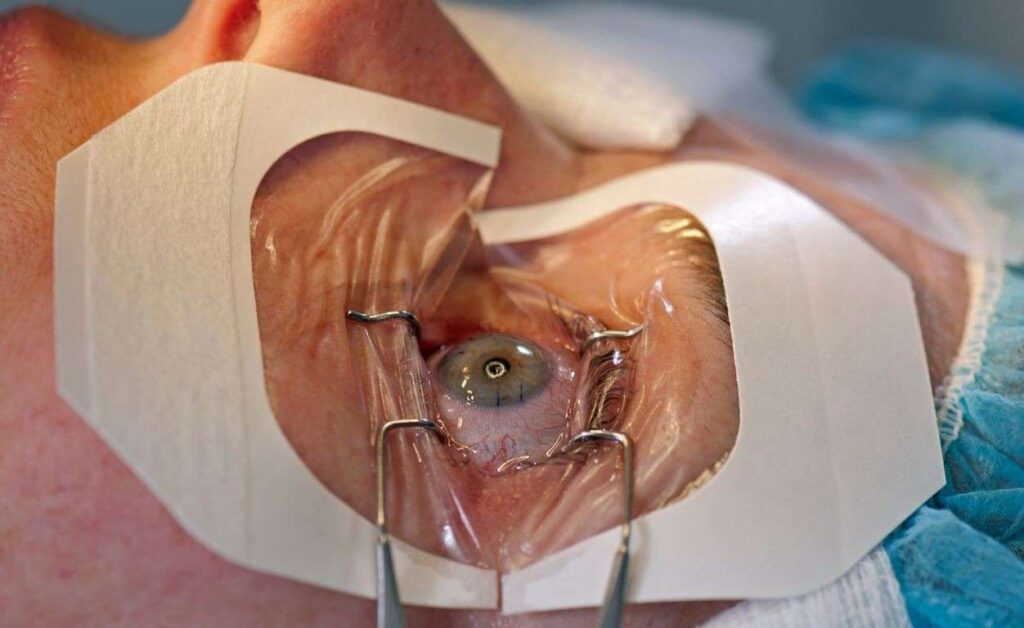In recent years, LASIK eye surgery has become increasingly popular as a way to correct vision problems. However, despite its widespread use, there are still many misconceptions and myths surrounding this procedure. In this article, we aim to debunk some of the most common myths about LASIK eye surgery and reveal the truth behind them.
Understanding LASIK Eye Surgery
LASIK, which stands for “Laser-Assisted In Situ Keratomileusis,” is a surgical procedure that uses a laser to reshape the cornea, the transparent front part of the eye. By altering the shape of the cornea, LASIK can correct refractive errors such as nearsightedness, farsightedness, and astigmatism.
But how exactly does LASIK work? Let’s dive into the details of this fascinating procedure.
The Intricate Process of LASIK

During the LASIK procedure, the surgeon creates a thin flap on the cornea using a microkeratome or femtosecond laser. This flap is then lifted, revealing the underlying cornea. The cornea is the part of the eye responsible for focusing light onto the retina, and any imperfections in its shape can lead to refractive errors. learn more about the types of Cataract surgeries by clicking here
With the cornea exposed, an excimer laser is used to reshape it. The excimer laser emits a cool, ultraviolet light beam that precisely removes tissue from the cornea in a predetermined pattern. This reshaping process allows the cornea to focus light more accurately onto the retina, correcting the refractive error.
Once the reshaping is complete, the surgeon gently repositions the corneal flap. This flap acts as a natural bandage, protecting the cornea and promoting healing. The remarkable thing about LASIK is that the cornea usually heals quickly, with minimal discomfort for the patient.
The Advantages of LASIK
LASIK tips offer several advantages over other vision correction methods. Firstly, the procedure is quick, typically lasting only about 15 minutes per eye. This means that both eyes can be treated in a single session.
Secondly, LASIK provides rapid results. Many patients experience improved vision immediately after the procedure, with further vision enhancement occurring over the following days and weeks.
Another advantage of LASIK is its long-lasting effects. In most cases, the corrected vision remains stable, reducing the need for further interventions. However, it’s important to note that individual results may vary, and some patients may require additional touch-ups in the future.
The Importance of a Qualified Surgeon
While LASIK is a safe and effective procedure, it’s crucial to choose a qualified and experienced surgeon. The surgeon’s expertise and precision play a significant role in the success of the surgery and the overall outcome.
Before undergoing LASIK, it’s essential to schedule a comprehensive consultation with a reputable eye care specialist. During this consultation, the surgeon will evaluate your eye health, discuss your expectations, and determine if you are a suitable candidate for LASIK. They will also explain the potential risks and benefits associated with the procedure, ensuring you have all the necessary information to make an informed decision.
In conclusion, LASIK is a remarkable surgical procedure that has transformed the lives of millions of people worldwide. By reshaping the cornea, LASIK corrects refractive errors and provides patients with clearer, sharper vision. If you are considering LASIK, take the time to research and consult with a qualified surgeon who can guide you through the process and help you achieve your vision goals.
Common Myths About LASIK Eye Surgery

LASIK eye surgery has gained significant popularity over the years as an effective solution for vision correction. However, there are still some common myths and misconceptions surrounding this procedure. Let’s explore and debunk a few of these myths to help you gain a better understanding of LASIK.
Myth 1: LASIK is Painful
One of the most common misconceptions about LASIK is that the procedure is painful. In reality, LASIK is virtually painless. Before the surgery, the eye is numbed using anesthetic eye drops. This helps ensure that patients do not experience any discomfort during the procedure itself. The surgeon may also provide a mild sedative to help patients relax. Some patients may feel slight pressure or a sensation of warmth, but these sensations are temporary and usually resolve quickly.
During the LASIK procedure, an ultra-thin flap is created on the cornea using a microkeratome or a femtosecond laser. The surgeon then uses an excimer laser to reshape the cornea, correcting any refractive errors. The entire process usually takes less than 15 minutes per eye, and most patients report minimal discomfort during and after the surgery.
Myth 2: LASIK Causes Night Vision Problems
Another myth surrounding LASIK is that it causes night vision problems, such as halos or glare. While it is true that some patients may experience temporary night vision disturbances immediately after LASIK, these issues usually subside within a few weeks as the cornea heals. In fact, studies have shown that LASIK can actually improve night vision for many patients, as it corrects the underlying refractive error.
The occurrence of night vision problems after LASIK is relatively rare and is more commonly associated with higher degrees of refractive error or pre-existing conditions such as large pupils. With advancements in technology and surgical techniques, the incidence of night vision problems has significantly decreased over the years. Surgeons carefully evaluate patients before the procedure to determine their candidacy and to minimize the risk of post-operative night vision issues.
Myth 3: LASIK is Not Permanent
There is a common misconception that the effects of LASIK eye surgery are not permanent and that glasses or contact lenses will still be needed in the future. However, LASIK provides long-lasting results. While it is true that the eye can undergo changes over time, LASIK permanently reshapes the cornea to correct refractive errors. The corneal tissue removed during the procedure does not regenerate, meaning that the effects of LASIK are indeed permanent.
While aging or other factors may affect vision down the line, LASIK can reduce the dependence on corrective lenses for many years. In some cases, an enhancement procedure may be required to fine-tune the vision if changes occur over time. However, the majority of LASIK patients enjoy clear and stable vision without the need for glasses or contacts for an extended period.
It is important to note that the success and longevity of LASIK outcomes depend on various factors, including the patient’s age, prescription, and overall eye health. Regular eye check-ups and proper post-operative care are essential to maintain optimal vision after LASIK.
In conclusion, LASIK eye surgery is a safe and effective procedure that offers long-lasting vision correction. By debunking these common myths, we hope to provide you with accurate information and alleviate any concerns you may have about LASIK. If you are considering LASIK, consult with a qualified eye surgeon who can evaluate your suitability for the procedure and address any questions or concerns you may have.
The Truth Behind the Myths
When it comes to LASIK, there are many misconceptions that can cause unnecessary worry or hesitation. However, it’s important to separate fact from fiction in order to make an informed decision about this life-changing procedure. Let’s take a closer look at some common myths surrounding LASIK and uncover the truth.
The Reality of LASIK Pain
One of the biggest concerns for individuals considering LASIK is the fear of experiencing pain during the surgery. Fortunately, this fear is largely unfounded. LASIK is a relatively painless procedure, thanks to the use of anesthetic eye drops. These drops ensure that patients do not experience any significant discomfort during the surgery. In fact, most patients report feeling only mild pressure or a sensation of slight discomfort, which quickly subsides.
After the LASIK procedure, it is normal to experience some mild eye irritation or dryness in the days following the surgery. However, these symptoms are temporary and can be easily managed with the use of prescribed eye drops. Within a short period of time, the eyes fully heal, and any discomfort dissipates, leaving patients with clear and comfortable vision.
Understanding Night Vision Post-LASIK
Another common misconception about LASIK is that it can negatively impact night vision. While it is true that some patients may experience temporary night vision disturbances immediately after the procedure, these issues are typically mild and resolve as the cornea heals. In fact, numerous studies have shown that the majority of LASIK patients experience improved night vision following the surgery.
The reduction in refractive errors achieved through LASIK allows light to focus more precisely on the retina, resulting in sharper and clearer vision even in low-light conditions. This improvement in night vision can greatly enhance one’s quality of life, especially for those who rely on good vision during nighttime activities such as driving or participating in outdoor sports.
The Longevity of LASIK Results
One of the most persistent myths about LASIK is that its results are not long-lasting. However, this couldn’t be further from the truth. While individual experiences may vary, the majority of LASIK patients can enjoy years, if not decades, of clear vision without the need for glasses or contact lenses.
It is important to note that age-related changes in vision may occur over time, as is the case with all individuals, regardless of whether they have had LASIK or not. However, the effects of LASIK are permanent, and the need for corrective lenses is significantly reduced for most patients. This means that even as the years go by, the vast majority of LASIK patients continue to enjoy the benefits of clear vision, allowing them to fully embrace their daily activities without the hassle of glasses or contacts.
By debunking these common myths surrounding LASIK, it becomes clear that this procedure is a safe, effective, and long-lasting solution for vision correction. If you are considering LASIK, it is important to consult with a qualified ophthalmologist who can provide personalized advice and address any concerns you may have. With the right information, you can make an informed decision and embark on a journey towards clearer vision and a brighter future.
The Benefits of LASIK Eye Surgery
Improved Vision
One of the main benefits of LASIK is improved vision. By correcting refractive errors, LASIK allows individuals to see clearly without the need for glasses or contact lenses. Whether it’s reading a book, driving a car, or participating in sports, LASIK can greatly enhance the quality of life for those who undergo the procedure.
Quick Recovery Time
Another advantage of LASIK is its relatively quick recovery time. Most patients experience improved vision within a day or two after the surgery. While it may take a few weeks for the full effect of the procedure to be realized, many individuals are able to resume their normal activities, including work and exercise, within a few days.
Long-Term Cost Effectiveness
While the upfront cost of LASIK may seem substantial, it can be a cost-effective option in the long run. By reducing or eliminating the need for glasses or contact lenses, LASIK can save individuals money on prescription eyewear, annual eye exams, and contact lens supplies. Over time, the savings can offset the initial cost of the procedure.
In Conclusion
LASIK eye surgery is a safe and effective procedure that can correct refractive errors and improve vision. By debunking common myths about LASIK, we hope to provide accurate information and help individuals make informed decisions about their eye health. If you are considering LASIK, it is important to consult with a qualified eye surgeon who can evaluate your eligibility and provide personalized advice. Remember, the truth is within reach – LASIK can provide lasting vision correction and a life free from the limitations of glasses or contact lenses.
